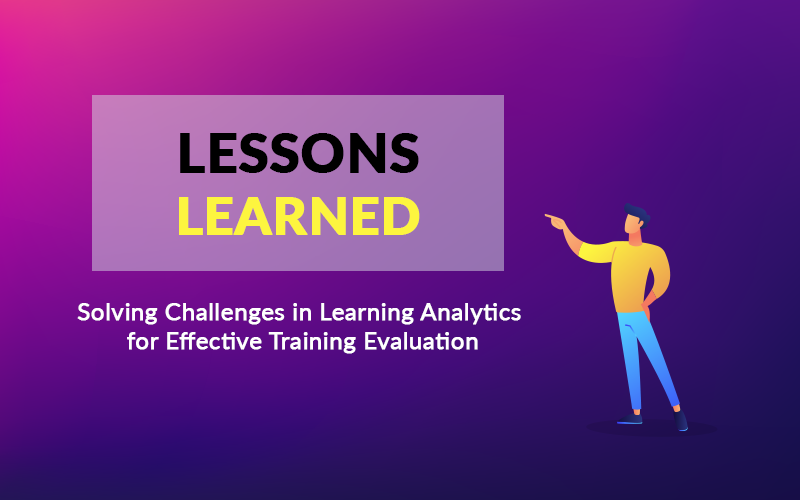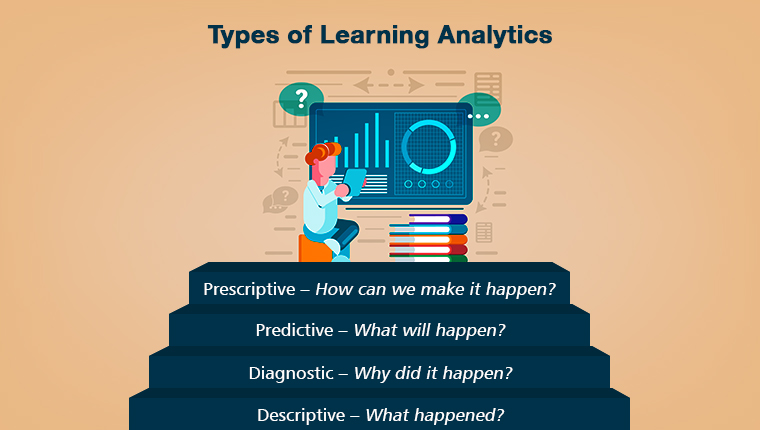7 Steps to Implement Learning Analytics in Corporate Online Training
Is your online training driven by learning analytics? Read this blog on how to implement learning analytics for a data-driven corporate training plan.

‘Data, data everywhere, but not a thought to think!’ – What does this popular quote by John Allen Paulos mean, do you think? Just this – there is no dearth of data anywhere, on anything. But without properly interpreting it, understanding its implications, and taking the correct actions, it is all a waste. And this applies equally well to training – classroom or online. That is where learning analytics comes in.
Register to the live webinar on learning analytics to get the basics right.
The Importance of Data
“But where should I start?” As Sherlock Holmes said, “It is a capital mistake to theorize before one has data. Insensibly one begins to twist facts to suit theories, instead of theories to suit facts.” So, the first step is to gather data, which is necessary to make informative, analytical, and unbiased decisions, even in L&D.
“Where will all this data come from?” That’s easy – from anywhere and everywhere; from employees, from the LMS, from business growth reports, from feedback reports, and more.
Learning Analytics Implementation
Do it in 7 easy steps
- Analyze the potential of the existing data pool
- Build a team of data-literate leaders
- Introduce the technology and instruments for evaluation
- Identify Key Performance Indicators (KPIs)
- Fix bugs and provide constant support
- Compile data for reporting
- Act!
Employing data analytics in online training isn’t just a dream anymore. Businesses are becoming more and more interested in implementing learning analytics to measure training effectiveness. And here is how it works before, during, and after the eLearning program.
7 Steps to Implement a Data-driven Learning Analytics Design
1. Analyze the Potential of the Existing Data Pool
The truth is there is no lack of data to design a successful data-driven culture – we generate 2.5 quintillion bytes of it every day! But not every piece of data is relevant for your online training program.
So, you will need to analyze the quality of data being generated and check if it has the potential to steer the program toward achieving business objectives. If not, you will need to step back and re-evaluate the questions you’re asking to obtain the data. After all, the data you gather is only as good as the questions you ask.
2. Build a Team of Data-literate Leaders
Learning analytics has been a hot topic for discussions for years but its practical implementation in corporate training is fairly recent. Until lately, data analytics was used in every other sphere in business, except L&D. So, while there’s an abundance of data analysts out there, most do not really have a background in training. You will need to build a team with data-literate human resources who also have a fair knowledge of corporate online training.
In addition to data analysts, you’ll need qualified LMS administrators and IT support teams to help you in this venture.
3. Introduce the Technology and Instruments for Training Evaluation
Technology is the backbone of any successful data-driven learning plan. So planning for learning analytics to evaluate online training will require technological support as well as a Learning Management System (LMS), data analytics, and data visualization tools.
You do not need to invest in an advanced and innovative technology to get started with learning analytics. Start from the basics and concentrate on the instruments of data collection and analysis which are available to you, like your LMS or an LRS. But even so, your LMS should be able to support the analytical activity that’s needed. Most of the popular LMSs available in the market allow integration with a learning analytics engine. However, if your LMS doesn’t allow such integration, it is better to invest in a modern learning platform that does.
After you have decided on implementing a full-fledged data-driven plan, you can bring in AI into the fold. An AI-enabled analytics engine will provide better data reporting than the good old LMS.
4. Identify Key Performance Indicators (KPIs)
As we saw earlier, to power a successful training program, data has to be relevant. It should be able to indicate where the training program is headed at that point of time and what can be done to steer it toward the right direction. This is where KPIs come in. They are the key indicators of a business’ performance.
KPIs have long been used for evaluating organizational training. Traditional parameters that were employed included the number of people trained, passing scores, cost per employee, hours spent in training. Such KPIs are too simple to yield much useful information. Training KPIs need to focus on driving business goals and at the same must “keep up with the times” and changing technology.
A few KPIs which can power up your learning analytics are:
- Time to proficiency
- Knowledge retention and transfer of training to the job
- Employee engagement and satisfaction
- Net promoter score
- Impact on the team and/or the organization
5. Fix Bugs and Provide Constant Support
Having a data-driven training design is a continuous endeavor which will require full-time maintenance and support. This is why you need to have a dedicated team of IT personnel and LMS administrators. In case of any issues or functionality errors at any point, this team will be responsible to resolve the issue as soon as possible. Only then can you ensure your learners have a seamless training experience.
If you do not have the capacity to support a dedicated in-house team of LMS administrators, you can outsource the task to a trusted eLearning vendor.
6. Compile Data for Reporting
After all the data is captured and analyzed, the next task is reporting. Yes…sounds boring, but you can always liven it up with colorful pie-charts and figures. Jokes aside, reports are an important aspect of the entire data-driven training evaluation process. These reports will summarize the state of training to key decision makers. These reports can be descriptive, prescriptive, predictive, or diagnostic in nature. Hence, it is always recommended to provide both quantitative as well as qualitative data in the reports.
7. Take Action
All the data analytics in the world will not mean anything if you do not follow it with action. While it is up to the key decision makers in the organization to take major decisions regarding the training strategy, you as training managers need to do your best to continue to educate stakeholders. Your insights will ultimately influence all major training decisions, so ensure you make a strong business case for learning analytics and its role in improving training ROI.
Summing it Up!
Data is the new oil in today’s world. With workplace digitization and rapid escalation of smart-technologies, you need to buy into this new currency and plan for a data-driven, result-oriented online training strategy. Don’t you think it is time for you to become a SMART Training Manager? Here is a secret to become one – download our book on Learning Analytics and become an expert in data-driven training strategies.





